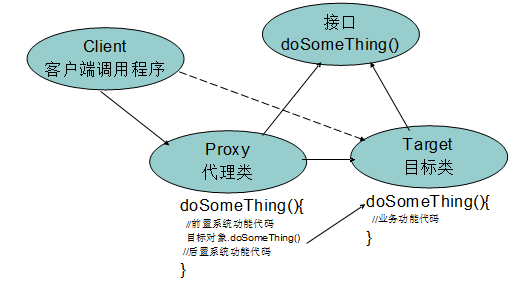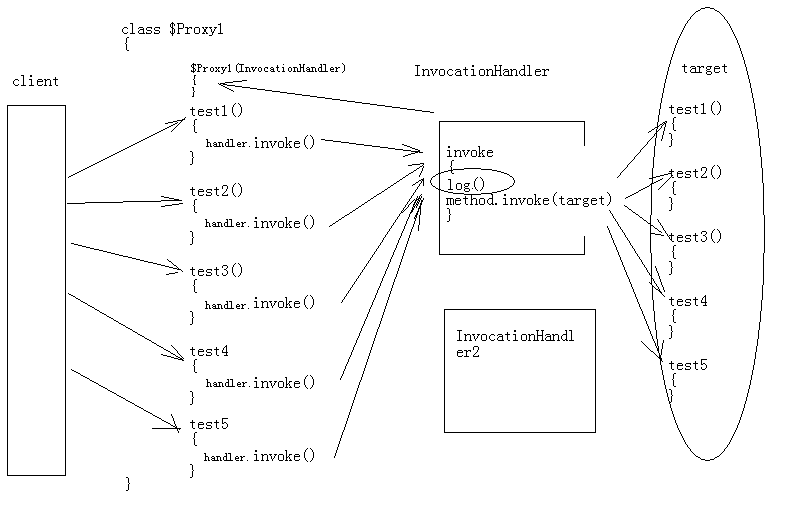概念
代理模式即Proxy Pattern,23种java常用设计模式之一。代理模式的定义:对其他对象提供一种代理以控制对这个对象的访问。比如要为已存在的多个具有相同接口的目标类的各个方法增加一些系统功能,例如,异常处理、日志、计算方法的运行时间、事务管理、等等可以用代理来实现

安全 事务 日志
StudentService ------|----------|------------|-------------
CourseService ------|----------|------------|-------------
MiscService ------|----------|------------|-------------
用具体的程序代码描述交叉业务:
method1 method2 method3
{ { {
------------------------------------------------------切面
.... .... ......
------------------------------------------------------切面
} } }
交叉业务的编程问题即为面向方面的编程(Aspect oriented program ,简称AOP),AOP的目标就是要使交叉业务模块化。可以采用将切面代码移动到原始方法的周围,这与直接在方法中编写切面代码的运行效果是一样的,如下所示:
------------------------------------------------------切面
func1 func2 func3
{ { {
.... .... ......
} } }
------------------------------------------------------切面
使用代理技术正好可以解决这种问题,代理是实现AOP功能的核心和关键技术。
动态代理技术
要为系统中的各种接口的类增加代理功能,那将需要太多的代理类,全部采用静态代理方式,将是一件非常麻烦的事情!写成百上千个代理类,是不是太累!
JVM可以在运行期动态生成出类的字节码,这种动态生成的类往往被用作代理类,即动态代理类。
JVM生成的动态类必须实现一个或多个接口,所以,JVM生成的动态类只能用作具有相同接口的目标类的代理。
CGLIB库可以动态生成一个类的子类,一个类的子类也可以用作该类的代理,所以,如果要为一个没有实现接口的类生成动态代理类,那么可以使用CGLIB库。
代理类的各个方法中通常除了要调用目标的相应方法和对外返回目标返回的结果外,还可以在代理方法中的如下四个位置加上系统功能代码:
1.在调用目标方法之前
2.在调用目标方法之后
3.在调用目标方法前后
4.在处理目标方法异常的catch块中
//通过Proxy.getProxyClass方法传入接口的类加载器和接口,返回该接口的代理类的 Class对象,。
Class clazzProxy1 = Proxy
.getProxyClass(Collection.class.getClassLoader(), Collection.class);
//得到代理类的名称
System.out.println(clazzProxy1.getName());// 返回代理类所有构造方法
Constructor[] constructors = clazzProxy1.getConstructors();
//以一定格式遍历构造方法
for (Constructor constructor : constructors) {
String name = constructor.getName();
//获取方法中所有参数类型
Class[] clazzParams = constructor.getParameterTypes();
StringBuilder sb = new StringBuilder(name);
sb.append('(');
//遍历所有参数类型
for (Class clazzParam : clazzParams) {
sb.append(clazzParam.getName()).append(',');
}
if (clazzParams != null && clazzParams.length != 0) {
sb.delete(sb.length() - 1, sb.length());
}
sb.append(')');
System.out.println(sb.toString());
}
//构造方法打印结果是com.sun.proxy.$Proxy0(java.lang.reflect.InvocationHandler)
//说明代理类只有一个有参的构造方法 Method[] methods = clazzProxy1.getMethods();
for (Method method : methods) {
String name = method.getName();
//获取方法中所有参数类型
Class[] clazzParams = method.getParameterTypes();
StringBuilder sb = new StringBuilder(name);
sb.append('(');
//遍历所有参数类型
for (Class clazzParam : clazzParams) {
sb.append(clazzParam.getName()).append(',');
}
if (clazzParams != null && clazzParams.length != 0) {
sb.delete(sb.length() - 1, sb.length());
}
sb.append(')');
System.out.println(sb.toString());
}
//发现遍历的结果是Constructor接口中的方法 // 通过反射获取指定参数类型的构造方法,传入参数类型InvocationHandler.class
Constructor constructor = clazzProxy1.getConstructor(InvocationHandler.class);
class MyInvocationHandler implements InvocationHandler {
@Override
public Object invoke(Object proxy, Method method, Object[] args) throws Throwable {
return null;
}
}
//实例化参数的时候传入的是参数类型的实例对象,InvocationHandler是接口,所以要写一个类实现它
Collection proxy1 = (Collection) constructor.newInstance(new MyInvocationHandler());
System.out.println(proxy1);//返回null
System.out.println(proxy1.toString());// 也返回null说明toString方法返回null
//上面两步可以使用匿名内部类实例化
Collection proxy2 = (Collection) constructor.newInstance(new InvocationHandler() {
@Override
public Object invoke(Object proxy, Method method, Object[] args) throws Throwable {
return null;
}
}); //通过Proxy.newProxyInstance方法直接实例化
Collection proxy3 = (Collection) Proxy.newProxyInstance(
Collection.class.getClassLoader(),
new Class[]{Collection.class},
new InvocationHandler() {
ArrayList target=new ArrayList();
//传入三个参数分别 是:代理对象,代理调用的方法,方法传入的参数
@Override
public Object invoke(Object proxy, Method method, Object[] args) throws Throwable {
return method.invoke(target, args);
}
});
proxy3.add("zhangsan1");
proxy3.add("zhangsan2");
proxy3.add("zhangsan3");
System.out.println("size="+proxy3.size());三个方面:
生成的类中有哪些方法,通过让其实现哪些接口的方式进行告知;
产生的类字节码必须有个一个关联的类加载器对象;
生成的类中的方法的代码是怎样的,也得由我们提供。把我们的代码写在一个约定好了接口对象的方法中,把对象传给它,它调用我的方法,即相当于插入了我的代码。提供执行代码的对象就是那个InvocationHandler对象,它是在创建动态类的实例对象的构造方法时传递进去的。在上面的InvocationHandler对象的invoke方法中加一点代码,就可以看到这些代码被调用运行了。
分析动态生成的类的内部代码
首先动态生成的类实现了Collection接口(可以实现若干接口),生成的类有Collection接口中的所有方法和一个如下接受InvocationHandler参数的构造方法。代码如下
$Proxy0 implements Collection
{
InvocationHandler handler;
public $Proxy0(InvocationHandler handler)
{
this.handler = handler;
}
}$Proxy0 implements Collection
{
InvocationHandler handler;
public $Proxy0(InvocationHandler handler)
{
this.handler = handler;
}
//生成的Collection接口中的方法的运行原理
int size()
{
return handler.invoke(this,this.getClass().getMethod("size"),null);
}
void clear(){
handler.invoke(this,this.getClass().getMethod("clear"),null);
}
boolean add(Object obj){
handler.invoke(this,this.getClass().getMethod("add"),obj);
}
}动态代理的工作原理图

怎样将目标类传进去?
直接在InvocationHandler实现类中创建目标类的实例对象,可以看运行效果和加入日志代码,但没有实际意义。
为InvocationHandler实现类注入目标类的实例对象,不能采用匿名内部类的形式了。
让匿名的InvocationHandler实现类访问外面方法中的目标类实例对象的final类型的引用变量。
示例代码
private static Object getProxy(final Object target, final Advice advice) {
Object proxy3 = Proxy.newProxyInstance(target.getClass().getClassLoader(), target
.getClass().getInterfaces(), new InvocationHandler() {
@Override
public Object invoke(Object proxy, Method method, Object[] args) throws Throwable {
//之前硬编码
/* long beginTime=System.currentTimeMillis();
Object retVal = method.invoke(target, args);
long enfTime=System.currentTimeMillis();
System.out.println(method.getName()+"执行时间"+(enfTime-beginTime));*/
//将消息功能抽取出来
advice.beforMethod(method);
Object retVal = method.invoke(target, args);
advice.afterMethod(method);
return retVal;
}
});
return proxy3;
} final ArrayList list = new ArrayList();
Collection proxy4 = (Collection) getProxy(list, new MyAdvice());
proxy4.add("zhangsan1");
proxy4.add("zhangsan2");
proxy4.add("zhangsan3");
System.out.println("size=" + proxy3.size());public interface Advice {
public void beforMethod(Method method);
public void afterMethod(Method method);
}public class MyAdvice implements Advice {
private long begTime;
@Override
public void beforMethod(Method method) {
System.out.println("方法开始执行");
begTime = System.currentTimeMillis();
}
@Override
public void afterMethod(Method method) {
long endTime = System.currentTimeMillis();
System.out.println(method.getName() + "执行时间:" + (endTime - begTime));
System.out.println("方法执行结束");
}
}实现AOP功能的封装与配置
工厂类BeanFactory负责创建目标类或代理类的实例对象,并通过配置文件实现切换。其getBean方法根据参数字符串返回一个相应的实例对象,如果参数字符串在配置文件中对应的类名不是ProxyFactoryBean,则直接返回该类的实例对象,否则,返回该类实例对象的getProxy方法返回的对象。
BeanFactory的构造方法接收代表配置文件的输入流对象,配置文件格式如下:
#xxx=java.util.ArrayList
xxx=cn.itcast.ProxyFactoryBean
xxx.target=java.util.ArrayList
xxx.advice=cn.itcast.MyAdvice
代码编写步骤
public class BeanFactory {
Properties props = new Properties();
public BeanFactory(InputStream ips) {
try {
props.load(ips);
} catch (IOException e) {
e.printStackTrace();
}
}
@SuppressWarnings("rawtypes")
public Object getBean(String name) {
String className = props.getProperty(name);
Object bean = null;
try {
Class clazz = Class.forName(className);
bean = clazz.newInstance();
} catch (Exception e) {
e.printStackTrace();
}
//如果bean是代理对象,就返回代理
if (bean instanceof ProxyFactoryBean) {
ProxyFactoryBean proxyFactoryBean=(ProxyFactoryBean)bean;
Advice advice=null;
Object target=null;
try {
advice = (Advice)Class.forName(props.getProperty(name+".advice")).newInstance();
target = Class.forName(props.getProperty(name+".advice")).newInstance();
} catch (Exception e) {
e.printStackTrace();
}
proxyFactoryBean.setAdvice(advice);
proxyFactoryBean.setTarget(target);
Object proxy = proxyFactoryBean.getProxy();
return proxy;
}
//如果bean不是代理类直接返回bean
return bean;
}
}public class ProxyFactoryBean {
private Advice advice;
private Object target;
public Advice getAdvice() {
return advice;
}
public void setAdvice(Advice advice) {
this.advice = advice;
}
public Object getTarget() {
return target;
}
public void setTarget(Object target) {
this.target = target;
}
public Object getProxy() {
Object proxy = Proxy.newProxyInstance(target.getClass().getClassLoader(), target.getClass()
.getInterfaces(), new InvocationHandler() {
@Override
public Object invoke(Object proxy, Method method, Object[] args) throws Throwable {
advice.beforMethod(method);
Object retVal = method.invoke(target, args);
advice.afterMethod(method);
return retVal;
}
});
return proxy;
}
}public class AopFrameworkTest {
public static void main(String[] args) {
InputStream ips = AopFrameworkTest.class.getResourceAsStream("config.properties");
Object bean=new BeanFactory(ips).getBean("xxx");
System.out.println(bean.getClass().getName());
}
}xxx=java.util.ArrayList
xxx=darkhorse.enhance.day02.proxy.aopframework.ProxyFactoryBean
xxx.advice=darkhorse.enhance.day02.proxy.MyAdvice
xxx.target=java.util.ArrayList





















 136
136

 被折叠的 条评论
为什么被折叠?
被折叠的 条评论
为什么被折叠?








